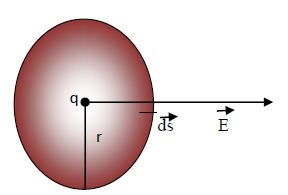Gauss Theorem Proof
Description:
To prove Gauss Theorem, we need to prove Φ = q/ ε0
We know that for a closed surface ∮ E→ . dA→ = Φ = q/ ε0 ............(1)
First we will calculate LHS of equation (1) and prove that it is equal to RHS
Proof
Step 1
Consider a sphere with a point charge ‘q’ as its centre and radius as ‘r’. Since the charge is a point charge so the electric field will be radial in all directions.

Step 2
Take an infinitely small area on the surface.
So, the electric field at a distance ‘r’ over the Gaussian surface due to charge ‘q’ will be: Er = 14πε0 qr2
Step 3
Multiply both side of the equation with dS.
We get − ∮ E→ . dA→ = ∮ 14πε0 qr2 dS
⇒ 14πε0 qr2 ∮dS ..........(2)
(Here; 4πε0 ,q, r are constants)
Now complete area of a sphere = ∮ dS = 4πr2
Putting the value in equation (2) we get −
∮ E→ . dA→ = Φ = q/ ε0 ..........(3)
We can see that ; equation (1) = equation (3)
Since LHS = RHS, Hence Gauss theorem is proved.
The total flux according to our knowledge is ∮ E.dS
Since electric field E ∝ 1/r2. That means it follows inverse square law.
Suppose electric field does not follow inverse square law, instead it follows inverse cube law as in case of a dipole.
In that case E ∝ 1/r3
So, in case of a dipole E = 14πε0 qr3
On Multiply both side of the equation with dS.
We get − ∮ E.dS = ∮ 14πε0 qr3dS
⇒ 14πε0 qr3 ∮ dS ............(2)
(Here; 4πε0, q, r are constants)
Now complete area of a sphere = ∮ dS = 4πr2
Putting the value in equation (2) we get −
⇒ ∮ Er.dS = q/ ε0 ≠ Φ ............(3)
The above equation is not satisfying Gauss Theorem.
So Gauss Theorem is applicable only when electric field follows inverse square law.

